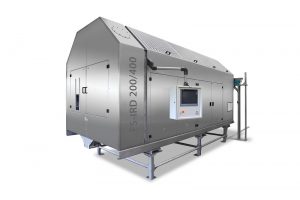Salmonella has no business being on our plates!
The innovative KREYENBORG FoodSafety-IRD technique provides security, as product recalls are unsettling to consumers, and cast manufacturers in a bad light.
Update: September, 2016:
Several companies have recalled sesame products. Salmonella was found in various products in testing. Among them were herbs, spices, nuts, seeds, teas and other dried foodstuffs, due to their natural micro-flora, and as result of using natural fertilizers, but because of various post-harvest factors are also not uncommonly contaminated with microorganisms. Apart from enterobacteria, salmonella was detected frequently. Salmonella are rod-shaped bacteria that are frequently transmitted by animals. Salmonellosis is the classic food-borne infection. Symptoms include diarrhea and fever. Additionally, there is the threat of damage to intestines, heart, liver, kidneys, and gall bladder. In elderly and immune-deficient people, such infections can be fatal.
It’s noteworthy, that according to a long-term study: “Salmonella in Herbs and Spices,” authored by H. Hartwig, A. Schloesser, W. Rabsch and G. Beckmann, published in 2006, high rates of contamination are often found in fennel (8.2%), anise (15.5%), anise-fennel-caraway tea (14.6%) and sesame (9.4%)! In this long-term study, the average contamination level of salmonella in spices was approximately 4%! Beyond that, a not-inconsiderable estimated number of cases must be assumed. The distribution of a salmonella contamination in a dry matrix is very inhomogeneous. We’re talking here about the so-called formation of nests. This leads to the salmonella contamination going undetected, despite careful quality control.
The KREYENBORG FoodSafety-IRD technique leaves Salmonella no chance of survival!
After three years of development, KREYENBORG today has produced over 5,000 seamlessly documented disinfection analyses of over 100 different dry products. The statistical evaluation of these data pools is confirmed and certified through an available independent validation report:
Microbial reduction by means of the FoodSafety-IRD is significantly greater than 10 log5 and is therefore well-suited for the disinfection of heavily contaminated goods.
In contrast to conventional methods of germ reduction, the FoodSafety-IRD technique is also effective with tenacious spore-forming bacteria, such as with Bacillus Cereus.
A further validity evaluation certificate confirms that the FoodSafety-IRD procedure kills salmonella safely and surely.
It was proven that the contents and the composition of essential oils were minimally or not at all compromised.
It is thus clear:
The FoodSafety-IRD technique eliminates one of the most crucial sources of infection to humans in our foodstuffs and raw materials. If a raw material is treated with this light-emitting infrared procedure, salmonella cannot survive, and the last stray nests are eradicated. That is real food safety!
How does the procedure work?
Our FoodSafety-IRD method is first and foremost a thermal technique, with a distinct, decisive difference from all conventional technologies:
Heat is fed to the raw material via infrared light. This wave-particle energy of the IR spectrum is conveyed directly into the product. The light-energy is transformed into heat in the product interior. The product is thus warmed from the inside out. The product particles can be simultaneously cooled from the outside by means of water mist.
This protects the high-quality raw material during the heat exchange while the germs, as a result of the heat of vaporization, can be intensively treated for short periods. What’s more, microorganisms react sensitively to specific light frequencies. The bottom line: light can be precisely controlled and dosed like no other energy-transfer medium.
Further useful applications of the FoodSafety-IRD include:
This technology can be directly connected downstream in a convective belt-dryer as a booster (for final drying). This has various advantages:
-Improvement of dryer throughput, up to 40%
-Improvement of product end-quality from a sensory perspective
-Improvement of microbiological results
-Reduction of drying costs
Additionally, the FoodSafety-IRD technique is especially suited to roasting and/or toasting of pre-dried raw material foodstuffs.
In contrast to conventional, convective treatment methods, this new technique is not controlled by the temperature of the heat-transfer medium, but rather precisely, and very quickly, by the product temperature.
Focused infrared light penetrates the surface of the product particles and is converted in the product interior into heat. In the shortest time, and with maximum protection of the product, the desired degree of roasting/toasting is achieved.
Simultaneous, safe stock protection.
Goods treated one time with our FoodSafety-IRD are simultaneously and securely stock-protected. Harmful insects and their laid eggs are found frequently in the innermost core of product particles. This makes combatting them particularly difficult. Any method of control must ensure that product particles are safely penetrated – be it with inert gas or with a corresponding temperature. Only in this way can the destruction of animal proteins be ensured. With inert gas treatment, as well as with convective warming treatment from the outside, there remains a certain risk! Not so with treatment using the FoodSafety-IRD. Because the product particles are swiftly heated from the inside to the outside, we quickly and safely accomplish the destruction of the animal proteins without thereby impairing the plant protein.


